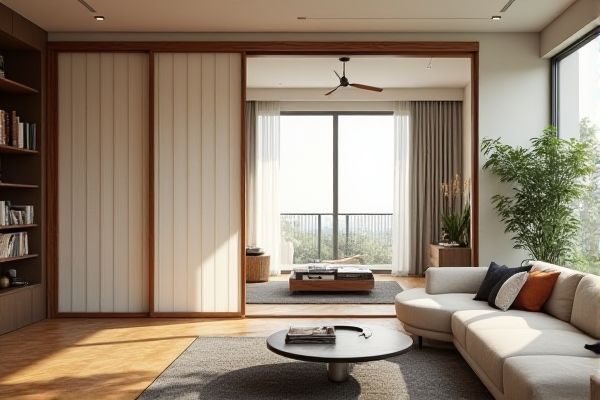
Sliding dividers offer smooth, space-saving panels that glide open and closed, ideal for creating flexible room separations without obstructing flow, while accordion dividers fold compactly, allowing for quick adjustments and easy storage, making them perfect for temporary or frequently changed layouts. Explore the rest of the article to discover which divider suits Your specific needs and design preferences.
Table of Comparison
| Feature | Sliding Divider | Accordion Divider |
|---|---|---|
| Interaction | User slides to resize panels | User clicks to expand/collapse sections |
| Use Case | Adjust panel widths dynamically | Show/hide content efficiently |
| Space Management | Flexible horizontal space allocation | Vertical stacking with collapsible content |
| Content Visibility | Multiple panels visible simultaneously | One or few sections visible at a time |
| Best For | Dashboard layouts, split views | FAQs, menus, content organization |
| Animation | Smooth sliding motion | Expand/collapse transitions |
Introduction to Room Dividers
Sliding dividers offer sleek, space-saving solutions by gliding smoothly on tracks, ideal for modern interiors needing flexible privacy and open layouts. Accordion dividers feature foldable panels that expand and contract effortlessly, providing versatile room separation with quick installation and easy storage. Your choice depends on the balance between aesthetic preference, functional requirements, and the room's spatial configuration.
What is a Sliding Divider?
A sliding divider is a dynamic interface element that allows users to adjust the size of adjacent panels by dragging a handle horizontally or vertically, improving space management and content visibility. Unlike an accordion divider, which expands and collapses sections sequentially, sliding dividers provide continuous, fluid resizing without fixed limits. This functionality enhances user experience in applications requiring customizable layouts, such as dashboards and design tools.
What is an Accordion Divider?
An accordion divider is a user interface element that allows multiple content sections to expand and collapse vertically, providing an organized and space-efficient way to display information. Each section's header can be clicked to reveal or hide its associated content, improving navigation and reducing clutter on websites or applications. Compared to sliding dividers, accordion dividers prioritize vertical stacking and user-controlled content visibility for enhanced readability.
Space Efficiency Comparison
Sliding dividers maximize space efficiency by smoothly gliding along a fixed track, allowing seamless separation without occupying additional room when opened. Accordion dividers compress neatly into a stacked formation, offering flexible partitioning but requiring more wall space due to their folding panels. Your choice depends on whether you prioritize a low-profile design or adaptable sectioning for variable space needs.
Aesthetic and Design Flexibility
Sliding dividers offer sleek, modern aesthetics with smooth motion and minimalist profiles, enhancing contemporary interiors with clean lines. Accordion dividers provide greater design flexibility by allowing varied panel materials, patterns, and customizable folding configurations, adaptable to diverse stylistic preferences. Your choice depends on whether you prioritize streamlined elegance or versatile visual impact in your space's layout.
Installation and Maintenance
Sliding dividers require precise track installation and periodic lubrication to ensure smooth operation, making initial setup slightly more complex but maintenance straightforward. Accordion dividers feature hinged panels that are easier to install on various surfaces but may demand frequent inspection of hinges and tracks to prevent wear and ensure flexibility. Both systems benefit from regular cleaning and occasional hardware tightening to maintain functionality and extend lifespan.
Sound Insulation and Privacy
Sliding dividers offer superior sound insulation due to their solid panels and tight seals that minimize noise transmission between spaces. Accordion dividers, while flexible and space-saving, often have segmented, thinner materials that provide less effective privacy and soundproofing. Your choice should consider that sliding dividers better preserve acoustic privacy in environments where noise control is crucial.
Cost Analysis: Sliding vs Accordion Dividers
Sliding dividers generally incur higher upfront costs due to complex track systems and durable materials, but offer long-term durability and smooth operation. Accordion dividers have a lower initial investment, utilizing lightweight and flexible panels, yet they may require more frequent maintenance or replacement in high-traffic areas. Cost analysis indicates sliding dividers are more economical for long-term use, while accordion dividers suit short-term or budget-sensitive applications.
Best Use Cases for Each Divider
Sliding dividers are ideal for creating flexible, dynamic spaces where you frequently change room layouts or need smooth, space-saving transitions, such as in conference rooms or modern offices. Accordion dividers work best in environments requiring quick, straightforward partitioning with easy storage, like classrooms or banquet halls. Your choice depends on how often you need to reconfigure the space and the aesthetic or functional demands of the area.
Conclusion: Which Divider Suits Your Needs?
Sliding dividers offer a sleek, space-saving solution ideal for modern interiors requiring seamless transitions between areas. Accordion dividers provide flexible partitioning with easy adaptability for frequently changing room layouts and larger openings. Your choice depends on the desired balance between aesthetic appeal, space efficiency, and functional versatility in your environment.
 homyna.com
homyna.com